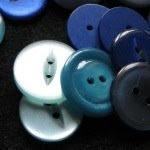The last week of hot weather has brought the plants on a treat. I was a little worried if they were going to survive, having been flooded 5 times over the winter, but it seems they are made of tough stuff and have come back bigger and better than before.
I love this plant. Even if I wasn't hooked on all things dyeing, I'd probably grow it for itself alone. Delicate, soft grey-green foliage, tall strong stems topped with amazing cartwheels of brilliant yellow. The plant itself isn't that elegant - a bit straggly, tall and leggy. If you don't have a dedicated bed for dye plants it might be worth growing it through something leafy. I'm tempted to move a plant or two to the front garden - to have it rambling through our reddish purple sumac might be quite something!
So, the plant, Anthemis tinctoria. Long known as a dye-plant- hence it's scientific name. As a rule of thumb, if a species is called tinctoria, it's going to dye things. The 'how' and 'what colour' is another matter, but dye it will.
These plants I raised from seed. Sown in seed trays in the spring with no protection (it's do or die for seedlings round here, only the strong survive!) they quickly form little rosettes of frondy grey-green leaves on a tough white, scaly root. When big enough to handle comfortably (about 5-8 cms across) plant out at about 30cms apart. They wilt. Almost immediately, they will flop and you will think you've killed them. Fear not! Keep them well watered for a week or so and they will quickly perk up and grow away fast. It is native to the Mediterranean and it's fine, slightly downy leaves are a protection against too much water loss in it's typical dry habitat. So is the wilting.
It's a tough plant. Though it's distribution and form should mean it prefers dryish soils, I've grown it well on everything from pure clay to sand. And while it is in a light sandy soil at the moment, I can't really say it's in a dry position, what with the Amber coming out of her banks to play each winter. Still, the plants have taken no harm and have been bursting with colour for the last few days.
The flowers are now drying, flat on a board and out of direct sun. They are best used fresh but I've used several years old dried ones in the past. The colour is a little paler and it takes a little longer for the dye bath to develop, but they still work perfectly well. As you might expect, they give a lovely warm yellow on wool - a clear sunshiny colour. On cotton it is paler, but still beautiful.
I thin, weather permitting, it's going to be a great crop this year. Plenty for me, plenty for sale. And next year, with luck and the co-operation of the Amber, there should be new young plants from cuttings



